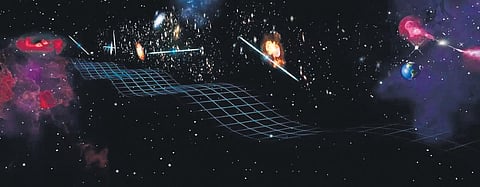

It all started with “hearing something”. Then they suspected it was the “music of the Universe”…And ended up detecting the most powerful gravitational waves passing through the Milky Way, the galaxy which hosts our Solar System, which Earth is a part of.
Astrophysicists at the North American Nanohertz Observatory for Gravitational Waves (NANOGrav) have detected space-time distortions caused by so far the biggest gravitational wave ever detected — so big, that the distance between two adjoining crests of the gravitational wave shrinks and expands from two light years to ten lightyears. That is a range from nine trillion kilometres to 90 trillion kilometres, according to the new study by a team of researchers with the US National Science Foundation's NANOGrav Physics Frontiers Centre, published on June 29 in The Astrophysical Journal Letters.
The distortions in space are the effects of space-time warping due to the gravitational waves passing through the universe. Space-time is a physical reality consisting of three dimensions in space (3D) and one dimension of time to make it a four-dimensional model in the Theory of Special Relativity.
The researchers began by analysing burned-out stars, called millisecond pulsars. Pulsars are rotating neutron stars observed to have pulses of radiation at very regular intervals, typically ranging from milliseconds to seconds. Pulsars have very strong magnetic fields which funnel jets of particles out along the two magnetic poles. The millisecond pulsars rotate hundreds of times per second and emit radio pulses like ticks from highly accurate cosmic clocks.
The scientists created a "detector" of 67 pulsars across space. They deducted it was a gravitational wave background causing the distortion of space. The team discovered what appeared to be variations in the ticking rate of such pulsars by comparing observations of more than 60 pulsars within radio telescope data spanning 15 years. That led to evidence of the biggest gravitational wave distorting the fabric of physical reality of space-time.
Albert Einstein first predicted gravitational waves in 1916. But they remained hypothetical until 2015 when the US-based Laser Interferometer Gravitational-Wave Observatory detected grav waves. Its spatial distortion was smaller than the nucleus of an atom. Compared to that, the NANOGrav-detected grav wave flexing of space-time was as big as an American football field.